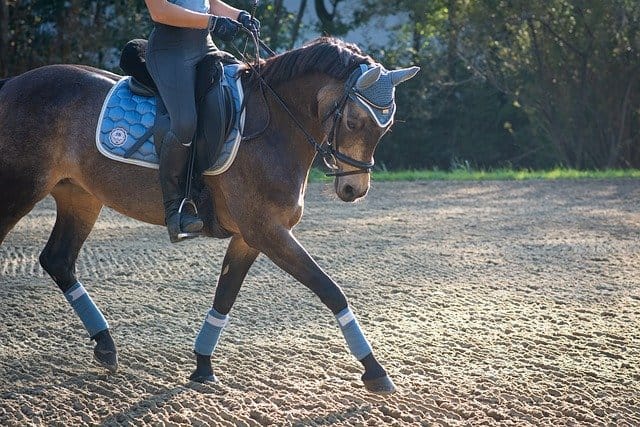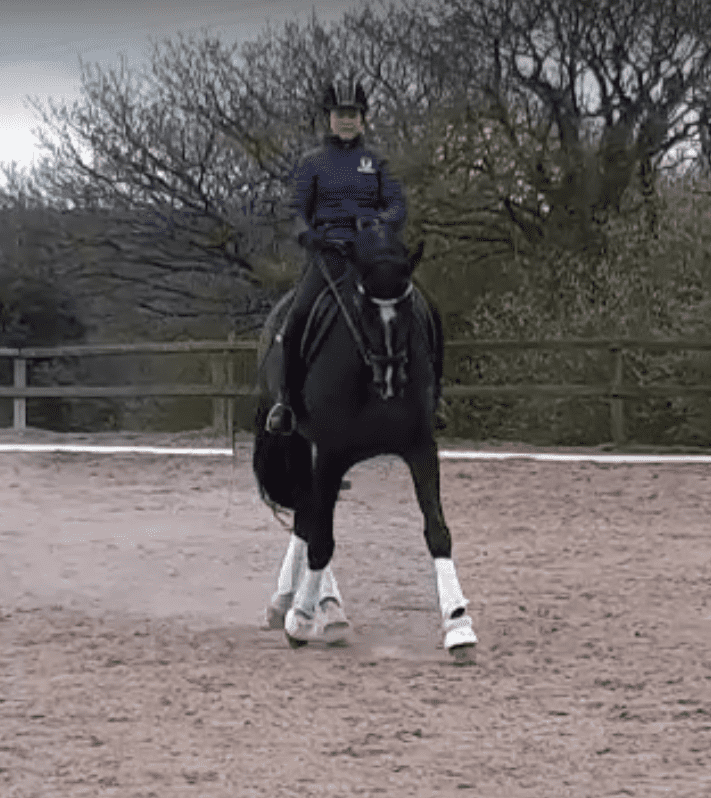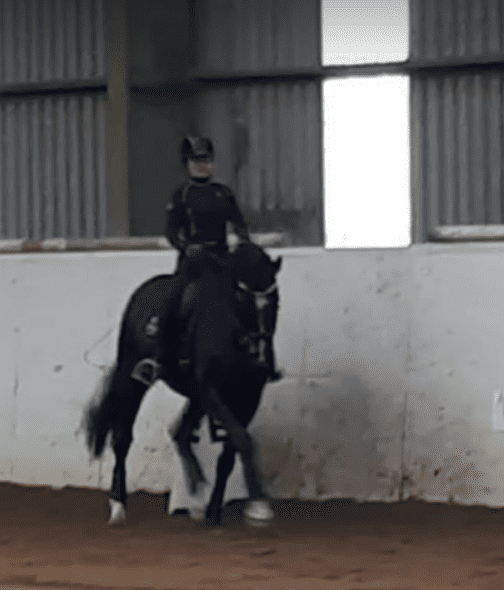What is Lateral Work for Horses?
Lateral work for horses, is when we ask our horses to move forward and sideways at the same time. This work includes everything from Leg Yield, Shoulder Fore and Shoulder In, up to Travers, Renvers and Half Pass.

The Benefits of Lateral Work
Why do we teach our horses Lateral Work? Quite simply if you are interested in improving your horse’s way of going, teaching them lateral work must be on your to do list.
Lateral work has so many benefits to your horse; it improves the engagement of the hind leg, and therefore lightening of the forehand. It will also improve your horse’s flexibility both laterally and longitudinally, while also improving your horse’s straightness. Lateral exercises help to make your horse more responsive and therefore easier to ride. You may be saying to yourself, this all seems very useful, but where do I start? Well the best place to start is with Leg Yield.
Before Your Get Started.
Before you begin teaching your horse Lateral work, they should be performing basic flat work correctly, i.e. working in a relaxed outline, obedient to your upward and downward aids, while also able to bend correctly when performing basic circles etc.
Leg Yield
Leg Yield is normally the first Lateral Exercise taught to both horse and rider. The horse moves forwards and sideways, with a slight bend away from the direction in which he is moving.
Leg Yield is a super Lateral Exercise to begin with, as it doesn’t require too much in the way of collection as some of the other Lateral Exercises do and introduces your horse to lateral work and prepares them for the more difficult movements.

Start in walk by coming down the ¾ line of the school, keep your horse marching forward, using your inside leg just behind the girth and ask your horse to move away from your leg. You can in the early stages open your inside rein slightly so that you horse bends away from the direction of movement. The outside rein maintains contact to control the bend of the head and neck and prevent the horse falling out through the shoulder. You can also put a little more weight into the outside stirrup to encourage the horse to move across. Remember to keep your hips and shoulders Parallel with your horses.
If the horse doesn’t move away from your leg, don’t jam on your leg aid, encourage your horse to move over by gently tapping with your dressage stick to ask them to be more attentive to your leg. If you feel your horse begin to shorten his stride, ride forwards, and try again down the next ¾ line. Two or three good steps of your horse understanding what is asked of him, is more beneficial than a whole long side of doing things incorrectly.
The wonderful thing about leg yield is that it can be performed when out hacking on tracks or quiet roads, as the horse will normally be drawn to moving to the edge of the road or track. Plus horses tend to be more forward thinking when hacking, which can be beneficial to you in the beginning.
When your horse gets the hang of Leg Yield in Walk you can move onto trot. Remember if you feel your horse shorten his stride, ride forwards, establish a forward trot and give the movement another go on the next ¾ line.
Shoulder In
Shoulder In is normally the second lateral exercise taught to horses and riders. It is initially ridden along the long side of the school, with the horse’s shoulders being brought off the track at an angle of approximately 30 degrees. The horse is asked to bend around the rider’s inside leg, with the bend being just enough to see the corner of the horse’s eye. The horse moves forward and sideways along the track and the angle of his body should remain consistent throughout the movement. Shoulder In was traditionally ridden on 3 tracks, however, 4 tracks is now also acceptable once the angle remains consistent throughout the movement.

Teaching Your Horse Shoulder In
Begin by getting an active trot, start by riding a 10 metre circle just after the corner of the school. As you complete the circle, start the movement as if you were about to perform another 10 metre circle but as the horse’s forehand just comes off the track ask them to continue up the long side of the school, by applying more inside leg. Aim for 3 tracks and to keep the angle of the horse’s body consistent throughout the exercise. When the horse moves on 3 tracks, the outside hind leg is on its own track, the inside hind leg steps into the track of the outside foreleg and inside foreleg is on its own track.
As with the Leg yield your shoulders and hips are parallel to the horses, while you look forward in the direction in which you are going. The inside rein maintains the bend, and the outside rein controls the bend and prevents the horse falling out through the shoulder. Your inside leg remains on the girth, maintaining the bend and also keeping your horse moving forward, while your outside leg is behind the girth to control the quarters and prevent them from falling out.
Trouble Shooting Shoulder In
If during Shoulder In you find that your horse begins to shorten their stride, or you begin to lose the angle, ride the horse onto a 10 metre circle and then ask for a few more steps as you come out of the 10 metre circle. Always complete the Shoulder In exercise by straightening your horse at the end of the long side at the quarter marker and ride positively forwards. In the early stages, I have always found that performing just a few steps correctly with plenty of praise and encouragement, then moving on to some forward work and then repeating the exercise, keeps the horse sweet and enjoying the process of learning.
The Key to Lovely Lateral Work.
The Key to Lovely Lateral work is to give clear concise aids, ask for just a few steps in the beginning, only looking for more as your horse becomes more comfortable. Offer plenty of praise when your horse gets things right and you will find this will make him a more willing participant. Although we all want the perfect end result, it is worth remembering to Enjoy the Process.
This article was originally published in the March 2021 Issue of Irish Sport Horse Magazine. A Special Thank You to Irish Para Dressage Rider Angela Lyons for allowing us to use the Pictures of her and Tommy.
